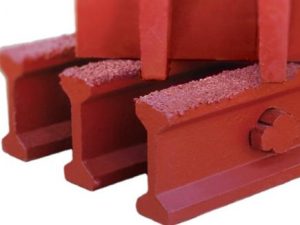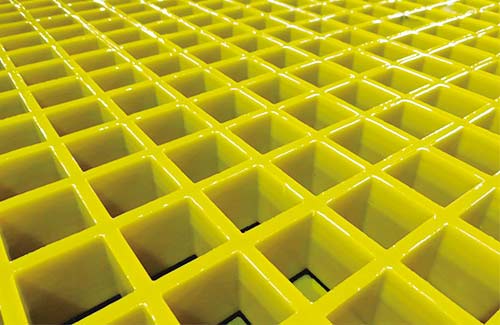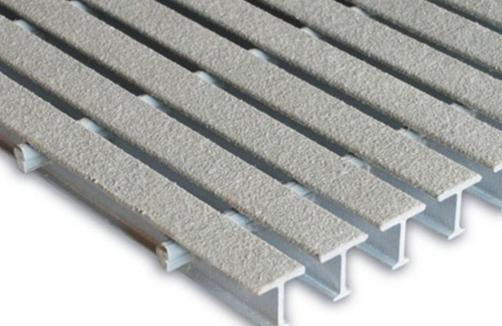In recent years, there has been a growing emphasis on sustainability and environmental responsibility across various industries. One material that is gaining significant attention for its eco-friendly properties is Fiber-Reinforced Polymer (FRP) pultruded grating. This innovative composite material offers numerous environmental benefits, making it an attractive choice for construction and industrial applications. In this article, we will explore the environmental advantages of using FRP pultruded grating, including its reduced carbon footprint, durability, and recyclability.
1. Introduction to FRP Pultruded Grating
Fiber-Reinforced Polymer (FRP) pultruded grating is a composite material made from resin and high-strength fibers, typically glass or carbon. The manufacturing process, known as pultrusion, involves pulling continuous strands of fiber through a resin bath and then through a heated die, where the resin cures to form a solid, reinforced profile. This process results in a strong, lightweight, and corrosion-resistant material that is ideal for a wide range of applications, including walkways, platforms, stair treads, and more.
2. Reduced Carbon Footprint
One of the most significant environmental benefits of FRP pultruded grating is its lower carbon footprint compared to traditional materials like steel and concrete. Here are some key factors contributing to this advantage:
– Energy-Efficient Manufacturing Process: The pultrusion process is highly energy-efficient, requiring less energy than the production of steel or aluminum. This is because the curing process in pultrusion uses less heat, and the continuous production method minimizes waste.
– Lightweight Material: FRP pultruded grating is significantly lighter than steel, which reduces the energy required for transportation and installation. This not only lowers fuel consumption but also reduces emissions associated with logistics.
– Longer Lifespan: Due to its excellent resistance to corrosion and weathering, FRP pultruded grating can last much longer than traditional materials. This extended lifespan means fewer replacements, reducing the overall environmental impact over time.
3. Durability and Longevity
The durability and longevity of FRP pultruded grating contribute to its environmental benefits by reducing the need for frequent replacements and maintenance. Here’s how:
– Corrosion Resistance: Unlike metal grating, FRP pultruded grating does not corrode, even in harsh environments such as those with high humidity, saltwater, or chemical exposure. This eliminates the need for regular painting or other protective coatings, which can be both costly and environmentally harmful.
– Resistance to UV and Weathering: FRP pultruded grating is designed to withstand prolonged exposure to sunlight and extreme weather conditions without degrading. This ensures that the material remains structurally sound and aesthetically pleasing for many years.
– Low Maintenance Requirements: The minimal maintenance required for FRP pultruded grating translates into lower use of cleaning agents and other chemicals, further reducing the environmental impact.
4. Recyclability and End-of-Life Management
While FRP pultruded grating is highly durable, it is also important to consider its end-of-life management. Although FRP is not as easily recyclable as some other materials, there are several ways to manage it sustainably:
– Recycling Programs: Some manufacturers have developed recycling programs for FRP products. These programs involve grinding the material into small particles that can be used in new composite products or as filler in other applications.
– Repurposing: Used FRP pultruded grating can often be repurposed for less demanding applications, extending its useful life and reducing waste.
– Energy Recovery: In cases where recycling is not feasible, FRP can be incinerated to recover energy. Modern incineration processes are designed to minimize emissions and maximize energy recovery, making this a viable option for end-of-life management.
5. Case Studies: Successful Implementation of FRP Pultruded Grating
To illustrate the environmental benefits of FRP pultruded grating, let’s look at a few case studies from different industries:
– Chemical Plant Walkways: A large chemical plant in Texas replaced its existing steel walkways with FRP pultruded grating. The new grating not only provided better resistance to the corrosive chemicals but also required no painting or maintenance. Over a 20-year period, the plant estimated a 30% reduction in carbon emissions and a 50% reduction in maintenance costs.
– Marine Platform Upgrades: An offshore oil platform in the North Sea upgraded its access platforms and walkways with FRP pultruded grating. The lightweight nature of the material allowed for easier installation, reducing the need for heavy lifting equipment and minimizing the environmental impact. Additionally, the non-corrosive properties of FRP ensured that the platform remained safe and functional in the harsh marine environment.
– Wastewater Treatment Facility: A wastewater treatment facility in California replaced its aging concrete and steel structures with FRP pultruded grating. The new grating provided better resistance to the corrosive environment and required minimal maintenance. The facility reported a 40% reduction in annual maintenance costs and a 25% reduction in overall carbon emissions.
6. Economic and Environmental Synergy
The environmental benefits of FRP pultruded grating are often accompanied by economic advantages, creating a synergy that makes it an attractive choice for businesses. Here are some key points to consider:
– Lower Initial Costs: While the initial cost of FRP pultruded grating may be higher than traditional materials, the long-term savings in maintenance and replacement costs can result in a lower total cost of ownership.
– Reduced Downtime: The durability and low maintenance requirements of FRP pultruded grating mean less downtime for repairs and replacements, improving operational efficiency and productivity.
– Sustainability Reporting: Many companies are now required to report on their environmental performance. Using FRP pultruded grating can help businesses meet their sustainability goals and improve their environmental reporting metrics.
7. Challenges and Considerations
While FRP pultruded grating offers numerous environmental benefits, there are also some challenges and considerations to be aware of:
– Initial Investment: The higher initial cost of FRP pultruded grating can be a barrier for some projects. However, the long-term savings and environmental benefits often justify the investment.
– Recycling Infrastructure: The recycling infrastructure for FRP is still developing, and not all regions have facilities to handle FRP waste. This can make end-of-life management more challenging.
– Material Properties: While FRP pultruded grating is highly durable and resistant to many environmental factors, it may not be suitable for all applications. For example, it may not have the same load-bearing capacity as steel in certain situations.
8. Future Trends and Innovations
As the demand for sustainable and eco-friendly materials continues to grow, the FRP industry is likely to see several innovations and trends:
– Improved Recycling Technologies: Advances in recycling technologies are expected to make it easier and more cost-effective to recycle FRP materials, further enhancing their environmental credentials.
– Biobased Resins: Research is ongoing into the development of biobased resins, which could reduce the environmental impact of the raw materials used in FRP pultruded grating.
– Enhanced Durability and Performance: Ongoing research and development are focused on improving the durability and performance of FRP pultruded grating, making it even more suitable for a wider range of applications.
9. Conclusion
Fiber-Reinforced Polymer (FRP) pultruded grating offers a range of environmental benefits that make it an excellent choice for construction and industrial applications. Its reduced carbon footprint, durability, and recyclability contribute to a more sustainable and eco-friendly solution compared to traditional materials like steel and concrete. By choosing FRP pultruded grating, businesses can not only reduce their environmental impact but also achieve long-term cost savings and improved operational efficiency.
As the world continues to prioritize sustainability, the adoption of FRP pultruded grating is likely to increase, driven by its proven environmental and economic advantages. Whether for new construction projects or the replacement of existing structures, FRP pultruded grating provides a compelling solution for those looking to build a greener future.







